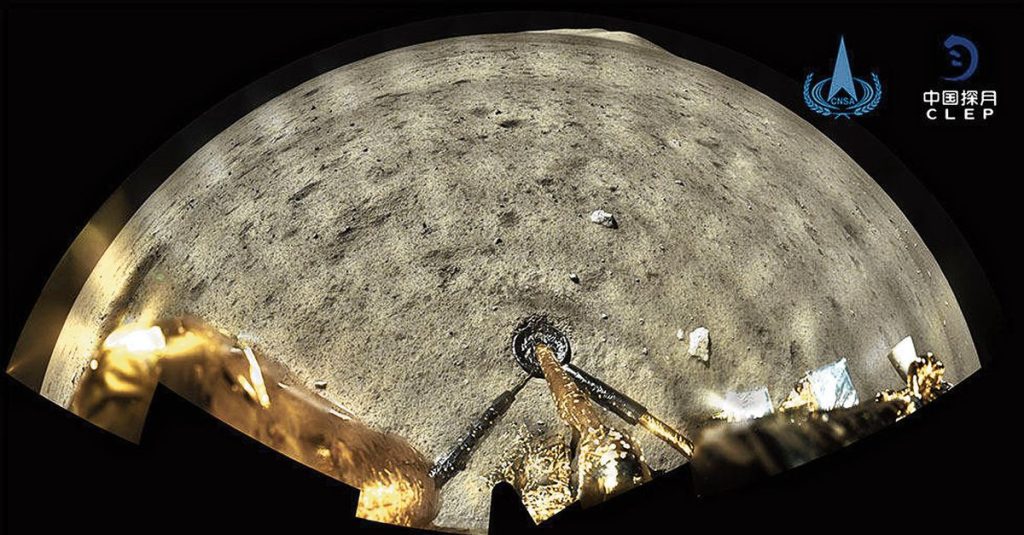Two billion years ago, volcanoes were still active on the Moon. This is much shorter than the previous measurements suggested. A group of international researchers came to this conclusion thanks to new moon rocks launched by China’s unmanned Chang’e 5 lunar mission at the end of last year. brought to earth. Researchers published Results this week Science.
The Moon is about 385,000 km from the Earth. It is much smaller (3474 km in diameter) than Earth, but it is the fifth largest of the more than two hundred moons in the Solar System.
The moon has active volcanoes. The surface is littered with cooling lava and some of the rocks brought in by previous lunar expeditions contain basalt. This type of rock consists of volcanoes. The eruptions may have looked similar to so-called hot volcanoes, such as those in Hawaii. In the process, a piece of Earth’s crust is melted from below by a steady local flow of hot, partially molten rock. Due to the increased pressure under the thin crust, magma eventually erupts through the crust.
While satellite images of the moon indicate that there may have been more recent volcanic eruptions in some places, evidence has only been found of active volcanoes that are at least three billion years old. Of the 380 kilograms of rock that the Apollo missions brought to Earth until 1972, and later among the rocks from other missions and lunar meteorites, not a single volcanic rock was less than three billion years old.
Carefully selected site
But among the samples of the new moon there were now two rocks from younger volcanoes. The stones were picked up by the Chinese Chang’e 5 lander. They landed at the end of last year in Oceanus Procellarum, a large lava plain on the Moon. Carefully chosen site. The surface there appears smaller than the rest of the moon. After dredging and digging, Chang’e 5 lifted a capsule filled with rocks into a mother ship orbiting the moon. The mother ship sent the rocks back to Earth via lunar orbit for research in the lab. Analysis of different variants of lead in individual basalt crumbs revealed that the igneous rocks are two billion years old.
“An exciting discovery,” says Wim van Westrenen, a lunar researcher at VU University Amsterdam who was not involved in the study. “Two billion years ago, according to models, the mantle would have cooled a lot due to volcanic activity. However, it is possible that heat-producing elements in the mantle may have reheated the magma locally.” These elements release heat through radioactive decay. “Many of these elements together behave like a kind of large domestic geyser, which could still create a hotspot two billion years ago. Only, strangely enough, those heat-producing elements were not found in the new samples at all.”
Does this mean that an unknown process will soon lead to a new volcanic eruption on the moon’s surface? “This is really unlikely. The Moon cools much faster than the Earth. The Moon is much smaller and hardly has an atmosphere. There is no water to facilitate the melting of the stone. I expect that the volcanic eruptions of two billion years ago were really the last.”
According to Bart Root, a planetary researcher at Delft University of Technology who was also not involved in the study, the most interesting thing about the discovery is that these planetary researchers help calculate the age of the geology of other celestial bodies. “To do this, we use a model based on the Moon. It takes samples of rocks in the laboratory on Earth, and so far we have only obtained them from the Moon. We apply this model to other celestial bodies, such as Mars, Mercury and Ganymede.”
A version of this article also appeared in NRC Handelsblad on October 8, 2021
A version of this article also appeared on NRC on the morning of October 8, 2021

“Total coffee specialist. Hardcore reader. Incurable music scholar. Web guru. Freelance troublemaker. Problem solver. Travel trailblazer.”







More Stories
GALA lacks a chapter on e-health
Weird beer can taste really good.
Planets contain much more water than previously thought